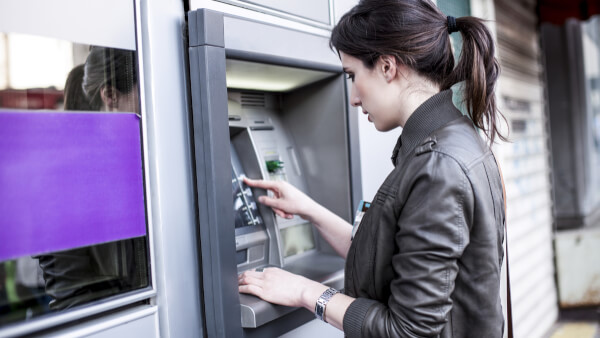Banque Postale withdrawal abroad from France: what are the fees?
Everything you need to know when travelling abroad with your Banque Populaire card: what are the fees and charges? How to reduce commissions?

If you have a Visa card from a French bank, your foreign payments and withdrawals are processed using either the Visa exchange rate or the interbank rate. However, that doesn’t mean you automatically benefit from these rates — extra fees often apply.
So, what’s the difference between the Visa rate and the interbank rate? And how can you avoid unnecessary fees when paying abroad from France? Let’s take a closer look.
To save on exchange costs, you could use an online platform like Wise, which applies the mid-market rate (also known as the interbank exchange rate) and transparent, low fees.
The interbank exchange rate, also called the mid-market rate, reflects the true market value of currencies — the price banks pay when they buy and sell currencies on the global market.
It’s essentially the midpoint between the buy and sell rates of major banks and is the fairest benchmark for currency conversion.
“Interchange” (or interchange fee) refers to the commission that the merchant’s bank pays to the customer’s bank when a card payment is made.
For example, when you buy something in a shop and pay by Visa card, your bank first sends the money to the shop’s bank. The shop’s bank then pays your bank a small interchange fee to cover costs such as transaction processing, fraud protection, and deferred debit options. This fee helps balance operational costs between banks.
The Visa exchange rate is set by the Visa payment network and is used to convert one currency into another. It often differs from the interbank (mid-market) rate.
Visa typically converts currencies immediately, but sometimes it performs a two-step process — first converting your purchase currency into a primary currency, then converting that into the currency of your card.
Keep in mind that Visa uses the rate effective on the day the transaction is processed, not necessarily the day of purchase. As a result, there can be small variations in the final amount.¹
Visa provides an online exchange rate calculator so you can check conversion rates and estimate how much your transaction will cost.
Simply enter the transaction details — amount, date, currencies, and your bank’s overseas fee — to see the total amount that will be charged to your card.
Most banks that issue Visa cards use this rate as the basis for conversions. However, many also add their own commissions on top of it, which they might not always disclose clearly.
If your bank refers to a “preferential rate” or “bank rate,” it likely means the Visa rate has been marked up.
When you use a Visa card outside the Eurozone, you might face both exchange rate differences and additional charges, such as:
Some French banks use the Visa exchange rate, others don’t. Even when they do, many add extra fees. Some banks reduce visible fees but make up for it by marking up the rate itself.
Either way, you’ll often end up paying more than if you used a provider that applies the mid-market rate with no hidden commissions.
If you want to avoid hidden bank fees, consider using a provider like Wise, which always uses the mid-market rate — the same rate you’ll find on currency markets.
With a Wise multi-currency account, you can hold 40+ different currencies and convert them instantly at the mid-market exchange rate, without hidden markups.
To order a Wise card, open an account online and submit your ID and proof of address for verification.
Once verified, your card will be sent to you. Activate it through your Wise account to retrieve your PIN and start using it.
Wise offers several benefits compared to most French banks:
The Wise card operates across both Visa and Mastercard networks. Simply top it up before use.
You can pay abroad like you would with any debit card. If you already hold the transaction currency, there are no fees. If a conversion is needed, a small exchange fee applies. Withdrawals are free up to €200 per month (two withdrawals), after which a 1.75% + €0.50 fee applies.
Wise applies a simple, transparent fee structure for foreign payments:
Yes. You can continue using your Wise card back in France for payments in euros without any extra charges.
It also comes with an IBAN, so you can receive transfers as easily as with a French bank account.
Source:
Last verified on October 10, 2025
This article is a translation of the original article published in French and was translated within 365 days of publication. While the content has been translated for accessibility, the data and sources referenced have not been updated since the original publication date.
*Please see terms of use and product availability for your region or visit Wise fees and pricing for the most up to date pricing and fee information.
This publication is provided for general information purposes and does not constitute legal, tax or other professional advice from Wise Payments Limited or its subsidiaries and its affiliates, and it is not intended as a substitute for obtaining advice from a financial advisor or any other professional.
We make no representations, warranties or guarantees, whether expressed or implied, that the content in the publication is accurate, complete or up to date.

Everything you need to know when travelling abroad with your Banque Populaire card: what are the fees and charges? How to reduce commissions?

Discover our tips for withdrawing money abroad with complete peace of mind, while minimizing bank fees and saving money during your travels.

Discover how to reduce withdrawal fees with your Crédit Mutuel card internationally. Practical tips for saving money while traveling.

Multi-currency cards are ideal for people who travel frequently or live abroad. Discover how to use them to save money.

Discover all the commissions on your payments abroad with a BNP Paribas international card: in the euro zone or outside.

How to choose your bank card for travel abroad based on your needs, income and spending habits?